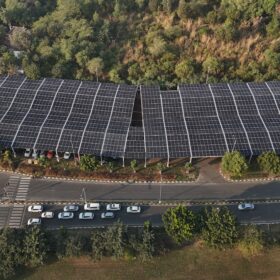The numbers are colossal. By 2030, India will have 2 lakh tons of solar waste. That’s the equivalent of around 4,400 Boeing 737-800s or 44,000 adult male Asian elephants – 110% of the global population.
Fast forward two decades and, with India set to deploy 2 TW of solar generation capacity in 2050, PV waste will weigh in at 18 lakh tons – almost 10 times more than the 2030 end-of-life panel pile.
Solar nations China, Germany and Japan will have the largest PV waste mountains in 2030, according to the International Renewable Energy Agency (IRENA), and by 2050 India will be number four in the unwanted ranking, behind China, the U.S. and Japan.
And yet, India still has no solar waste plan in place.
Not surprisingly, solar waste recycling was a hot topic at this year’s Renewable Energy India summit in New Delhi, with attendees split between concern at the lack of action and a blasé belief the 25-year lifetime of PV panels offers India plenty of time to get its house in order.
Piling up already
However, 25 years may be optimistic as IRENA has pointed to the rising volume of panels discarded long before that point thanks to improper installation, manufacturing defects, poor maintenance and soiling, and unforgiving climatic conditions.
Laws to manage electrical waste have been in place in India since 2011, and mandate only authorized dismantlers and recyclers collect such ‘e-waste’. However dead PV panels are still classed as general waste so the e-waste legislation does not apply.
The European Union defines solar panels as e-waste under its Waste Electrical and Electronic Equipment (WEEE) directive but when India implemented its E-waste (Management) Rules 2016 legislation, in October 2017, PV products were again absent.
The Ministry of New and Renewable Energy at least recognizes the problem and the concept note/blueprint on [the] management of antimony-containing glass from end-of-life … solar PV panels document it issued stated: “Management of PV module[s] need[s] to follow the cradle-to-grave lifecycle assessment in four stages: (1) component production; (2) module manufacturing; (3) module use; [and] (4) end of-life-use stage.”
Recyclers are available
The advisory note went on to add, disposing of solar panel glass in everyday hazardous treatment storage and disposal facilities should be considered the “least-preferred action” and only resorted to in the absence of recycling facilities in India. A Ministry of Environment, Forest and Climate Change report has stated 178 e-waste recyclers have been accredited by state governments.
A report by clean energy analyst Bridge to India stated: “Data from the Central Pollution Control Board (CPCB) show that [the] installed capacity of registered e-waste recyclers/dismantlers in the country is only about 0.4 million [4 lakh] tons per annum, 22% of the estimated e-waste volume.”
And not all of those registered recyclers handle solar waste. Poseidon Solar Services, based in Chennai, is among the few exceptions. Having started silicon recovery from discarded semiconductor wafers in 2004, Poseidon now offers cradle-to-grave PV solutions.
The company’s website states the volume of waste generated by solar cell manufacturers has overtaken the amount of silicon rejected by the semiconductor industry and is extremely valuable. The purity of silicon used in cell manufacture – more than 7N – means it can be used as a substitute for polysilicon, thus saving huge amounts of energy as around 200 kWh go into the manufacture of each kilogram of poly. “The recycling service reduces the energy consumption as well as the usage of the hazardous chemicals by the PV industry,” Poseidon states.
‘No need to panic’
Not everyone is concerned about India’s looming solar waste problem.
“Let’s get this straight, almost everything from a solar PV module can be recycled. Everything except the plastic sheets used to laminate the modules,” said Adarsh Das, CEO and co-founder of solar project developer SunSource Energy. “Both silicon based and thin-film based modules can be recycled using distinct industrial processes. Worldwide there are enough available technologies, some even reaching an astonishing 96% recycling efficiency. Recycling technologies will get better in future so let’s not hype the horror of PV modules as environmental nightmare.”
Ahmedabad-based solar consultant Viren Choksi agreed, and told pv magazine: “Solar PV waste is not an imminent danger and recycling is not the need of the hour. We do require recycling norms and policies but they fall into place much before solar panels hit the minimum 25-year longevity mark. Let’s look at the example of electronic waste: India handles it so well. When time comes, PV waste will be handled equally well with technology and policies.”
Bridge to India has proposed mandating module manufacturers to take a sustainable approach to product development, similar to the EU’s eco-design initiative. The consultant has also mooted allocating the responsibility of each stakeholder for waste management; laying down standards for collection, treatment and disposal; beefing up producer responsibility organizations to handle PV waste; encouraging mutual recycling arrangements between module suppliers, project developers and power off-takers; and identifying the investment and technical requirements for establishing PV recycling facilities focusing on high-value recovery.
Who pays?
Manufacturers should shoulder the burden of mandatory recycling, Solar consultant Urvish Dave told pv magazine. He predicted India will have around 10 GW of solar waste if the nation hits its 100 GW generation capacity target by 2022 and said the situation will be exacerbated by the fact Indian-made modules last, at best, half as long as imports.
Another solution is to make panel buyers pay for recycling, according to a retired engineer from California who spoke to pv magazine anonymously. “Once the recycling ecosystem is in place, one sure way to address [the problem] is to integrate, in multi-year performa calculations, [the] cost of recycling PV waste at the time of purchase so the buyer is aware that she/he will be paying for recycling associated costs as well,” said the engineer.
IRENA estimates that by 2050, PV recycling will become a $15 billion (Rs10.6 lakh crore) global industry. If solar modules are recycled efficiently, by 2050, it would be possible to produce 200 crore new panels without new raw materials, enough products to generate around 630 GW.
This content is protected by copyright and may not be reused. If you want to cooperate with us and would like to reuse some of our content, please contact: editors@pv-magazine.com.








By submitting this form you agree to pv magazine using your data for the purposes of publishing your comment.
Your personal data will only be disclosed or otherwise transmitted to third parties for the purposes of spam filtering or if this is necessary for technical maintenance of the website. Any other transfer to third parties will not take place unless this is justified on the basis of applicable data protection regulations or if pv magazine is legally obliged to do so.
You may revoke this consent at any time with effect for the future, in which case your personal data will be deleted immediately. Otherwise, your data will be deleted if pv magazine has processed your request or the purpose of data storage is fulfilled.
Further information on data privacy can be found in our Data Protection Policy.